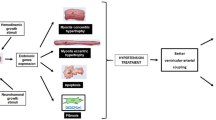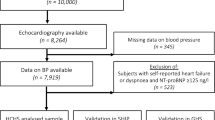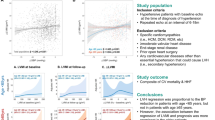Abstract
Left-ventricular hypertrophy (LVH) is a cardinal manifestation of hypertensive organ damage associated with an increased cardiovascular (CV) risk. We reviewed recent literature on the prevalence of LVH, as assessed by echocardiography, in order to offer an updated information on the magnitude of subclinical alterations in LV structure in contemporary human hypertension. A MEDLINE search using key words ‘left ventricular hypertrophy’, ‘hypertension’, ‘echocardiography’ and ‘cardiac organ damage’ was performed in order to identify relevant papers. Full articles published in English language in the last decade, (1 January 2000–1 December 2010), reporting studies in adult or elderly individuals, were considered. A total of 30 studies, including 37 700 untreated and treated patients (80.3% Caucasian, 52.4% men, 9.6% diabetics, 2.6% with CV disease) were considered. LVH was defined by 23 criteria; its prevalence ranged from 36% (conservative criteria) to 41% (less conservative criteria) in the pooled population. LVH prevalence was not different between women and men (range 37.9–46.2 versus 36.0–43.5%, respectively). Eccentric LVH was more frequent than concentric hypertrophy (range 20.3–23.0 versus 14.8–15.8, respectively, P<0.05); concentric phenotype was found in a consistent fraction (20%) of both genders. Despite the improved management of hypertension in the last two decades, LVH remains a highly frequent biomarker of cardiac damage in the hypertensive population. Our analysis calls for a more aggressive treatment of hypertension and related CV risk factors leading to LVH.
This is a preview of subscription content, access via your institution
Access options
Subscribe to this journal
Receive 12 digital issues and online access to articles
$119.00 per year
only $9.92 per issue
Buy this article
- Purchase on Springer Link
- Instant access to full article PDF
Prices may be subject to local taxes which are calculated during checkout


Similar content being viewed by others
References
Diez J, Frohlich E . A translational approach to hypertensive heart disease. Hypertension 2010; 55: 1–8.
Frohlich E, Gonzales A, Diez J . Hypertensive left ventricular hypertrophy risk: beyond adaptive cardiomyocytic hypertrophy. J Hypertens 2011; 29: 17–26.
Kehat I, Molkentin JD . Molecular pathways underlying cardiac remodeling during pathophysiological stimulation. Circulation 2010; 122: 2727–2735.
Schmieder RE . The role of non-haemodynamic factors in the genesis of LVH. Nephron Dial Transplant 2005; 20: 2610–2612.
de Simone G, Palmieri V, Bella JN, Celentano A, Hong Y, Oberman A et al. Association of left ventricular hypertrophy with metabolic risk factors: the HyperGEN study. J Hypertens 2002; 20: 323–331.
Vakili BA, Okin PM, Devereux RB . Prognostic implications of left ventricular hypertrophy. Am Heart J 2001; 141: 334–341.
Bombelli M, Facchetti R, Carugo S, Madotto F, Arenare F, Quarti-Trevano F et al. Left ventricular hypertrophy increases cardiovascular risk independently of in and out-of office blood pressure values. J Hypertens 2009; 27: 2458–2464.
Tsioufis C, Vezali E, Tsiachris D, Dimitriadis K, Taxiarchou E, Chatzis D et al. Left ventricular hypertrophy versus chronic renal disease as predictors of cardiovascular events in hypertension: a Greek 6-year-follow-up study. J Hypertens 2009; 27: 1705–1712.
Pierdomenico SD, Cuccurullo F . Risk reduction after regression of echocardiographic left ventricular hypertrophy in hypertension: a meta-analysis. Am J Hypertens 2010; 23: 876–881.
Mancia G, Laurent S, Agabiti-Rosei E, Ambrosioni E, Burnier M, Caulfield MJ et al. Reappraisal of European guidelines on hypertension management: a European Society of Hypertension Task Force document. J Hypertens 2009; 27: 2121–2156.
Ruilope LM, Schmieder RE . Left ventricular hypertrophy and clinical outcomes in hypertensive patients. Am J Hypertens 2008; 21: 500–506.
Fagard RH, Celis H, Thijs L, Wouters S . Regression of left ventricular mass by antihypertensive treatment. A meta-analysis of randomized comparative studies. Hypertension 2009; 54: 1084–1091.
Wachtell K, Bella JN, Liebson P, Gerdts E, Dahlof B, Aalto T et al. Impact of different partition values on prevalences of left ventricular hypertrophy and concentric geometry in a large hypertensive population. The LIFE Study. Hypertension 2000; 35: 6–12.
Saba MM, Ibrahim MM, Rizk H . Gender and the relationship between resting heart rate and left ventricular geometry. J Hypertens 2000; 19: 367–373.
Cipriano C, Gosse P, Bemurat L, Mas D, Lemetayer P, T’Tela G et al. Prognostic value of left ventricular mass and its evolution during treatment in the Bordeaux cohort of hypertensive patients. Am J Hypertens 2001; 14: 524–529.
Verdecchia P, Carini G, Circo A, Dovellini E, Giovannini E, Lombardo M et al. Left ventricular mass and cardiovascular morbidity in essential hypertension: The MAVI Study. J Am Coll Cardiol 2001; 38: 1829–1935.
Cuspidi C, Ambrosioni E, Mancia G, Pessina AC, Trimarco B, Zanchetti A . Role of echocardiography and carotid ultrasonography in stratifying risk in patients with essential hypertension: the Assessment of Prognostic Risk Observational Survey. J Hypertens 2002; 20: 1307–1314.
Mancia G, Carugo S, Grassi G, Lanzarotti A, Schiavina R, Cesana G et al. Prevalence of left ventricular hypertrophy in hypertensive patients without and with blood pressure control: data from the PAMELA population. Hypertension 2002; 39: 744–749.
Fesler P, Du Cailar G, Ribstein J, Mimran A . Left ventricular function in never-treated essential hypertension. J Am Soc Nephrol 2003; 14: 881–887.
Muiesan ML, Salvetti M, Monteduro C, Bonzi B, Paini A, Viola S et al. Left ventricular concentric geometry during treatment adversely affect cardiovascular prognosis in hypertensive patients. Hypertension 2004; 43: 731–738.
Conrady AO, Rudomanov OG, Zaharov DV, Krutikov AN, Vahrameeva NV, Yakovleva OI et al. Prevalence and determinants of left ventricular hypertrophy and remodeling patterns in hypertensive patients: The St. Petersburg Study. Blood Press 2004; 13: 101–109.
de Simone G, Kizer JR, Chinali M, Roman MJ, Bella JN, Best LG et al. Normalization for body size and population attributable risk of left ventricular hypertrophy. Am J Hypertens 2005; 18: 191–196.
Eguchi K, Kario K, Hoshide S, Ishikawa J, Morinari M, Shimada K . Type 2 diabetes is associated with left ventricular concentric remodeling in hypertensive patients. Am J Hypertens 2005; 18: 23–29.
Viazzi F, Parodi D, Leoncini G, Parodi A, Falqui V, Ratto E et al. Serum uric acid and target organ damage in primary hypertension. Hypertension 2005; 45: 991–996.
Glorioso N, Filigheddu F, Pinna Parpaglia P, Soro A, Troffa C, Argiolas G et al. 11beta-hydroxysteroid dehydrogenase type 2 activity is associated with left ventricular mass in essential hypertension. Eur Heart J 2005; 26: 498–504.
Verdecchia P, Angeli F, Gattobigio R, Sardone M, Porcellati C . Asymptomatic left ventricular systolic dysfunction in essential hypertension: prevalence, determinants, and prognostic value. Hypertension 2005; 45: 412–418.
de Simone G, Kitzman DW, Chinali M, Oberman A, Hopkins PN, Rao DC et al. Left ventricular concentric geometry is associated with impaired relaxation in hypertension: the HyperGEN study. Eur Heart J 2005; 26: 1039–1145.
Schillaci G, Pirro M, Pucci G, Mannarino MR, Gemelli F, Siepi D et al. Different impact of the metabolic syndrome on left ventricular structure and function in hypertensive men and women. Hypertension 2006; 47: 881–886.
Zanchetti A, Cuspidi C, Comarella L, Agabiti-Rosei E, Ambrosioni E, Chiarello M et al. Left ventricular diatolic dysfunction in elderly hypertensives: results of the APROS-diadys study. J Hypertens 2007; 25: 2158–2167.
Peterson GE, de Backer T, Gabriel A, Ilic V, Vagaonescu T, Appel LJ et al. Prevalence and correlates of left ventricular hypertrophy in the African American Study of kidney disease cohort study. Hypertension 2007; 50: 1033–1039.
Mulè G, Cusimano P, Nardi E, Cottone S, Geraci C, Palermo A et al. Relationship between metabolic syndrome and left ventricular mass in hypertensive patients: does sex matter? J Hum Hypertens 2008; 22: 788–795.
Tsioufis CP, Tsiachris DL, Selima MN, Dimitriadis KS, Thomopoulos CG, Tsiliggiris DC et al. Impact of waist circumference on cardiac phenotype in hypertensives according to gender. Obesity 2008; 17: 177–182.
Iwashima Y, Horio T, Kamide K, Tokudome T, Yoshihara F, Nakamura S et al. Additive interaction of metabolic syndrome on cardiac hypertrophy, and risk of cardiovascular disease in hypertension. Am J Hypertens 2010; 23: 290–298.
Yasuno S, Ueshima K, Oba K, Fujimoto A, Ogihara T, Saruta T et al. Clinical significance of left ventricular hypertrophy and changes in left ventricular mass in high risk hypertensive patients: a subanalysis of the Candesartan Antihypertensve Survival Evaluation in Japan Trial. J Hypertens 2009; 27: 1705–1712.
Castelpoggi CH, Pereira VS, Fiszman R, Cardoso CRL, Muxfeldt ES, Salles GF . A blunted decrease in nocturnal blood pressure is independently associated with increased aortic stiffness in patients with resistant hypertension. Hypertens Res 2009; 32: 591–596.
Cuspidi C, Giudici V, Lonati L, Sala C, Valerio C, Mancia G . Left ventricular hypertrophy detection and body mass index. Blood Press 2010; 19: 337–343.
Cuspidi C, Giudici V, Negri F, Sala C, Mancia G . Left ventricular geometry, ambulatory blood pressure and extra-cardiac organ damage in untreated essential hypertension. Blood Press Monit 2010; 15: 124–131.
de Simone G, Izzo R, Chinali M, De Marco M, Casalnuovo G, Rozza F et al. Does information on systolic and diastolic function improve prediction of a cardiovascular event by left ventricular hypertrophy in arterial hypertension? Hypertension 2010; 56: 99–104.
Cuspidi C, Negri F, Muiesan ML, Capra A, Lonati L, Milan A et al. Prevalence and severity of echocardiographic left ventricular in hypertensive patients in clinical practice. Blood Press 2010; 20: 3–9.
Noheria A, Mosley TH, Kullo IJ . Association of serum osteoprotegerin with left ventricular mass in African-American adults with hypertension. Am J Hypertens 2010; 23: 767–774.
Chahal NS, Lim TK, Jain P, Chambers JC, Kooner JS, Senior R . New insights into the relationship of left ventricular geometry and left ventricular mass with cardiac function: a population study of hypertensive subjects. Eur Heart J 2010; 31: 588–594.
Cerasola G, Nardi E, Mul G, Palermo A, Cusumano P, Guarneri M et al. Left ventricular mass in hypertensive patients with mild-to-moderate reduction of renal function. Nephrology 2010; 15: 203–210.
Devereux RB, Reickek N . Echocardiographic determination of left ventricular mass in man. Anatomic validation of the method. Circulation 1977; 55: 613–618.
Devereux RB, Alonso DR, Lutas EM, Gottlieb GJ, Camo E, Sachs I et al. Echocardiographic assessment of left ventricular hypertrophy: comparison to necropsy findings. Am J Cardiol 1986; 57: 450–458.
Cuspidi C, Esposito A, Negri F, Sala C, Masaidi M, Giudici V et al. Studies on left ventricular hypertrophy regression: a clear message for the clinician? Am J Hypertens 2008; 21: 458–463.
Gidding SS . Controversies in the assessment of left ventricular mass. Hypertension 2010; 56: 26–28.
Levy D, Savage DD, Garrison RJ, Anderson KM, Kannel WB, Castelli WP . Echocardiographic criteria for left ventricular hypertrophy: the Framingham Heart Study. Am J Cardiol 1987; 59: 956–960.
Okin PM, Gerdts E, Kjeldsen SV, Julius S, Edelman JM, Daholf B et al. Gender difference in regression of electrocardiographic left ventricular hypertrophy during antihypertensive therapy. Hypertension 2008; 52: 100–106.
Henry RMA, Kamp O, Kostense PJ, Spijkerman AMW, Dekker MD, Nijpels G et al. Mild renal insufficiency is associated with increased left ventricular mass in men, but not in women: an arterial stiffness-related phenomenon- The Hoorn Study. Kidney Int 2005; 68: 673–679.
Coca A, Gabriel R, de la Figuera M, Lopez-Sendon JL, Fernandez R, Sagastagoitia JD et al. On behalf the VITAE Investigators. The impact of different echocardiographic diagnostic criteria on the prevalence of left ventricular hypertrophy in essential hypertension. J Hypertens 1999; 17: 1471–1480.
Ghali JK, Liao Y, Cooper RS . Influence of left ventricular geometric patterns on prognoss in patients with r without coronary artery disease. J Am Coll Cardiol 1998; 31: 1635–1640.
Milani RV, Lavie CJ, Mehera MR, Ventura HO, Kartz JD, Messerli F . Left ventricular geometry and survival in patients with normal left ventricular ejection fraction. Am J Cardiol 2006; 97: 959–963.
Volpe M, Tocci G, Trimarco B, Agabiti-Rosei E, Borghi C, Ambrosioni E et al. Blood pressure control in Italy: results of recent surveys on hypertension. J Hypertens 2007; 25: 1491–1498.
Acknowledgements
We are grateful to Gil F Salles for providing the data of his study.
Author information
Authors and Affiliations
Consortia
Corresponding author
Ethics declarations
Competing interests
The authors declare no conflict of interest.
Rights and permissions
About this article
Cite this article
Cuspidi, C., Sala, C., Negri, F. et al. Prevalence of left-ventricular hypertrophy in hypertension: an updated review of echocardiographic studies. J Hum Hypertens 26, 343–349 (2012). https://doi.org/10.1038/jhh.2011.104
Received:
Revised:
Accepted:
Published:
Issue Date:
DOI: https://doi.org/10.1038/jhh.2011.104
Keywords
This article is cited by
-
Hypersensitive C-reactive protein as a potential indicator for predicting left ventricular hypertrophy in elderly community-dwelling patients with hypertension
BMC Cardiovascular Disorders (2023)
-
The prevalence of left ventricular hypertrophy associated with type-2 diabetes in Shiraz, Iran: a cross-sectional study
BMC Cardiovascular Disorders (2023)
-
Hypertension and cardiomyopathy associated with chronic kidney disease: epidemiology, pathogenesis and treatment considerations
Journal of Human Hypertension (2023)
-
Hypertensive organ damage: the vulnerable heart of women
Journal of Human Hypertension (2023)
-
A homogenized constrained mixture model of cardiac growth and remodeling: analyzing mechanobiological stability and reversal
Biomechanics and Modeling in Mechanobiology (2023)



